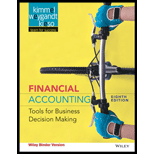
Concept explainers
(a)
Accounts receivable
Accounts receivable refers to the amounts to be received within a short period from customers upon the sale of goods and services on account. In other words, accounts receivable are amounts customers owe to the business. Accounts receivable is an asset of a business.
Bad debt expense:
Bad debt expense is an expense account. The amounts of loss incurred from extending credit to the customers are recorded as bad debt expense. In other words, the estimated uncollectible accounts receivable are known as bad debt expense.
Percentage-of-receivables basis:
It is a method of estimating the
Allowance method:
It is a method for accounting bad debt expense, where uncollectible accounts receivables are estimated and recorded at the end of particular period. Under this method, bad debts expenses are estimated and recorded prior to the occurrence of actual bad debt, in compliance with matching principle by using the allowance for doubtful account.
Direct write-off method:
This method does not make allowance or estimation for uncollectible accounts, instead this method directly write-off the actual uncollectible accounts, by debiting bad debt expense and by crediting accounts receivable. Under this method, accounts would be written off only when the receivables from a customer remain uncollectible.
To determine: The amount would be reported as bad debt expense, if Company M uses the direct write-off method of accounting for bad debts.
(b)
The amount of bad debts expense would be recorded by Company M.
(c)
The amount of bad debts expense would be recorded by Company M.
(d)
To describe: The weakness of reporting bad debt expense under direct write-off method.
Want to see the full answer?
Check out a sample textbook solution
Chapter 8 Solutions
Financial Accounting 8th Edition
- Can you explain this financial accounting question using accurate calculation methods?arrow_forwardCan you solve this general accounting problem using appropriate accounting principles?arrow_forwardDescribe various audit standards as formulated by ASB and PCAOB. (Each one of you can describe one standard at the minimum)arrow_forward
- I am looking for help with this financial accounting question using proper accounting standards.arrow_forwardNet assets (assets minus liabilities) at the beginning of the year were $75,000, and at the end of the year, they were $105,000. The common stock increased by $15,000 (due to new issuance) during the year. Dividends declared for the year were $28,000 for Northstar Industries. What must have been the net income for the year?arrow_forwardI am trying to find the accurate solution to this general accounting problem with the correct explanation.arrow_forward
- Please explain the solution to this financial accounting problem with accurate principles.arrow_forwardPlease provide the correct answer to this general accounting problem using valid calculations.arrow_forwardWHat is the role of AICPA in the audit of public companies. Describe the role of International Auditing and Assurance Standards Board (IAASB) and how it is relevant to the audits of the US companies.arrow_forward
- Principles of Accounting Volume 1AccountingISBN:9781947172685Author:OpenStaxPublisher:OpenStax College
 Cornerstones of Financial AccountingAccountingISBN:9781337690881Author:Jay Rich, Jeff JonesPublisher:Cengage Learning
Cornerstones of Financial AccountingAccountingISBN:9781337690881Author:Jay Rich, Jeff JonesPublisher:Cengage Learning Financial Accounting: The Impact on Decision Make...AccountingISBN:9781305654174Author:Gary A. Porter, Curtis L. NortonPublisher:Cengage Learning
Financial Accounting: The Impact on Decision Make...AccountingISBN:9781305654174Author:Gary A. Porter, Curtis L. NortonPublisher:Cengage Learning  College Accounting (Book Only): A Career ApproachAccountingISBN:9781337280570Author:Scott, Cathy J.Publisher:South-Western College Pub
College Accounting (Book Only): A Career ApproachAccountingISBN:9781337280570Author:Scott, Cathy J.Publisher:South-Western College Pub Intermediate Accounting: Reporting And AnalysisAccountingISBN:9781337788281Author:James M. Wahlen, Jefferson P. Jones, Donald PagachPublisher:Cengage Learning
Intermediate Accounting: Reporting And AnalysisAccountingISBN:9781337788281Author:James M. Wahlen, Jefferson P. Jones, Donald PagachPublisher:Cengage Learning





